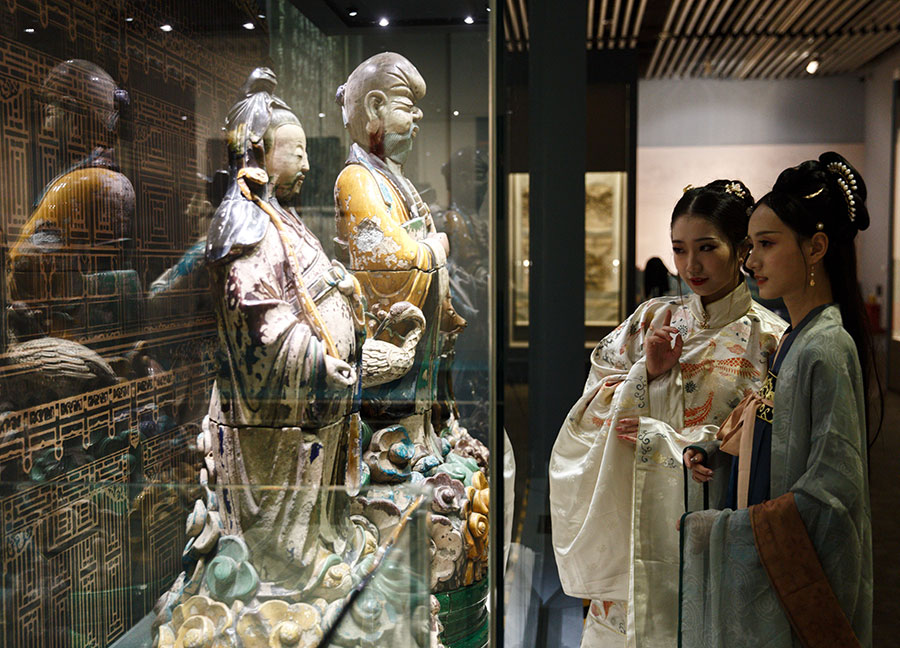Classic Chinese tales thrive in modern times
 0 Comment(s)
0 Comment(s) Print
Print E-mail China Daily, March 8, 2021
E-mail China Daily, March 8, 2021
Striking a fine balance
Starting from the first season of The Nation's Greatest Treasures in 2017, a variety show featuring highlighted collections in Chinese museums staged by China Central Television, creative programs promoting traditional Chinese culture have mushroomed on television screens.
Most of these shows used A-list celebrities to showcase the national treasures, thereby ensuring that the cultural relics strike a chord with young viewers.
Lyu Yitao, a member of the 13th National Committee of the CPPCC and a director of China Media Group for variety shows, believes that the success of such programs is a reflection of the social development of China in a new era.
"The young generation, especially those who are born after 1995 or 2000, grew up at a time when Chinese people's lives are much better and our national strength is rising," said Lyu. "They will naturally feel proud of and nurture a stronger curiosity of our own culture. The reason why such programs are popular is that they meet the audiences' need for culture at a deep level."
The previous two seasons of the show have been, or are in the process of being, translated into eight languages to be broadcast worldwide.
In spite of the previous reputation, continuous creativity is needed to meet people's differing tastes. In the third season of The Nation's Greatest Treasures, which premiered in December, homes of the treasured artifacts went beyond museums to larger heritage sites, which are "treasures" per se as well.
"We have tried to strike a balance between the rigorous popularization of knowledge and an entertaining format," Lyu said. "It's a way to link tradition and fashion."

Sometimes, such links of tradition and fashion on TV can create strong momentum, often beyond expectations, thanks to social media.
Last month, as numerous TV stations around the country made their own galas for the Spring Festival season, A Tang Dynasty Banquet, a five-minute-long dance on Henan TV featuring cultural relics, was perhaps the shiniest piece among the repertoires.
Fourteen dancers from Zhengzhou Song and Dance Theater dressed in Tang Dynasty (618-907) costumes, inspired by the glazed pottery figurines in Henan Museum, performed the dances. Augmented reality technology was used to mix other key collections from the museum into the performance, like an 8,000-year-old bone flute and a bronze wine vessel in the shape of owl dating back for over 3,000 years. The dance attracted over 2 billion views online, while relevant posts received 500 million clicks on social networking service Sina Weibo.
"New technology can bring more immersive experiences for those who worship cultural relics," said Ma Xiaolin, director of the Henan Museum. "It makes dialogue possible between the past and present, and makes history tangible for the younger generation."
Ma, who is also a member of the 13th National Committee of the CPPCC, said the museum received 8,000 visits daily during the Spring Festival holiday after the gala was broadcast, the maximum number allowed due to the COVID-19 restrictions.
On Feb 26, the Lantern Festival, the troupe staged a sparkling comeback, using the same approach to present a 30-minute online show, with the Henan Museum and other key cultural heritage sites in the province as backdrops.
"Thanks to cooperation between cultural heritage organizations and various media platforms, we have been able to offer a series of cultural products to the general public," said Ma. "But such a fad is not beneficial for ever. We have to embrace new platforms and not wait for more people to come to our venues."
Nevertheless, Ma feels that it is important to avoid excessive entertainment, as the focus shifts to increasing online flows through eye-catching gimmicks, rather than the revitalization of traditional culture.
"Social media makes information fragmented, but it's not that negative," Lyu added. "Culture thus has more chances to fill gaps in people's lives. It's time to use these fragmented information as teasers and attract more people to explore traditional culture at a deeper level."
Finding wider audiences
Wang Wei, president of the Chinese Society of Archaeology and a deputy to the 13th National People's Congress, agrees that the next phase of programs on traditional culture should transcend the "treasure" quotient.
This year marks the 100th anniversary of the founding of modern archaeology in China, following the discovery of the Yangshao Neolithic culture, around 7,000 years old, in Henan province.
Wang is currently cooperating with China Media Group to produce a variety show called Chinese Archaeology Conference. Though Wang did not reveal too many details about the show, he said the original idea of making just a quiz contest has been changed considering that such a format could distract attention about the significance of key archaeological discoveries.
"When it comes to such productions, there is not much that China has as reference as most of the similar overseas programs use the documentary form for narratives," he said. "We have made some achievements but that does not mean that we are satisfied with the current results. Cultural heritage values still need to be elaborated."
Wang, a leading archaeologist in China, said scholars need to be better trained in media interactions as the general public is becoming "more professional" due to the popularity of such TV shows in the past few years.
"People's interest in archaeology is sometimes beyond our expectations," said Wang.
Last year, online livestreams were organized for the first time to show the final round of appraisals to choose the country's 10 best archaeological discoveries. To Wang's surprise, the sessions full of archaeological terminology attracted over 28 million views. Since then, using livestreams to introduce the latest discoveries to the public has become a common practice for Chinese archaeologists.
b9b40a8c-effb-469f-9779-633e4d74aeef.jpeg)




Go to Forum >>0 Comment(s)